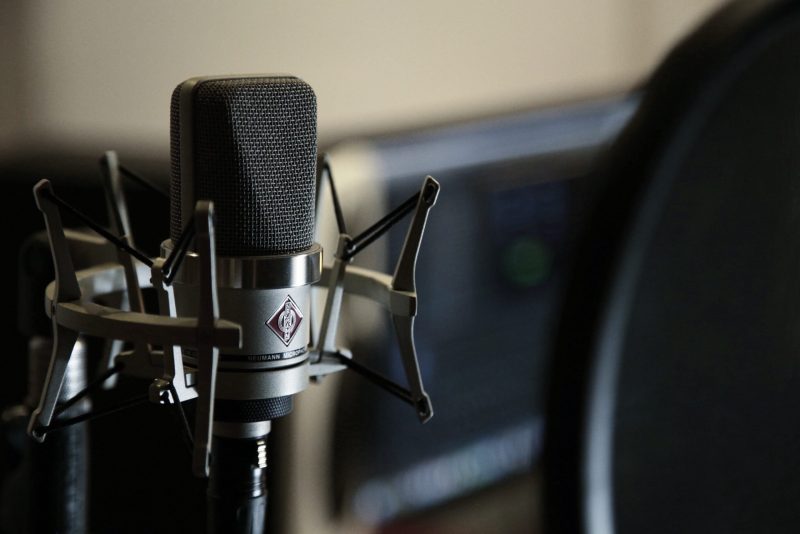Without a doubt, your microphone is the single most crucial piece of equipment in your recording studio. Without one, you won’t be able to capture your voice with clarity or produce the high-quality sound or professional finish your podcast needs to get noticed. Without the right microphone, you’re just yelling into the void.
The right microphone doesn’t just come along, though. You need to pay special attention to finding the perfect microphone for your show because getting the wrong one won’t only affect the quality of your recording. It’ll leave you with a gigantic hole in your bank balance too.

Two commons types of microphones used for podcasting – dynamic microphones and condenser microphones. But what does each type do? And how do you decide which is the best choice for your show?
It’s a technical jungle out there. To help you navigate your way safely to the best type of microphone for your podcast, we’ve broken down the differences between dynamic mics and condenser mics. Here you should find all the information you need to decide which is best for you and your show.
Table of Contents
What Do “Dynamic” & “Condenser” Mean?
First, let’s take a look at one piece of technology that every microphone needs to have to work correctly.
Within the construction of a microphone’s head, there is a device called a ‘transducer,’ which records the sound waves being fed into the microphone and converts them into electrical signals. The recorded messages transform from acoustic sound to digital sound.
The purpose of a transducer is to convert one form of energy into another. In the case of microphones, the sensor turns sound into electrical signals, taking your voice and turning into something that a computer can understand.
There are three main types of transducer used in microphones: Dynamic, Condenser, and Ribbon, and it’s the first two most commonly used for sound recording. But which one is the best for podcasting?
Dynamic Microphones
How Does a Dynamic Microphone Work?
Dynamic microphones have a relatively simple construction and work on the principle of electromagnetism. It involves a small wire (known as a voice coil) being connected to the plastic back of the microphone (known as the diaphragm) and surrounded by a magnet. That creates a constant magnetic field.
As acoustic sound waves enter the microphone, the diaphragm vibrates to the frequency of the waves, and the voice coil moves with it. It produces a small electrical charge that converts sound energy to electrical energy.
Is a Dynamic Microphone Good for Podcasting?
Since recording vocals is the main objective of a podcast, a dynamic microphone would be the right choice for podcasting. It will be able to pick up a different range of frequencies and convert them into clear, consistent sounds.
Dynamic microphones are also an excellent choice for podcasts with multiple hosts or guests or recording in a noisy environment such as a coffee shop or restaurant. They’ll pick up more of the vocals directly in front of them, rather than trying to pick up as much sound as possible.
As a bonus, dynamic microphones are generally cheaper than condenser microphones, making them an excellent choice for a low-budget podcast. Budget-consciousness makes them a perfect choice for anybody new to podcasting but wants to get a professional piece of equipment at the lower end of the price range.
Condenser Microphones
How Does a Condenser Microphone Work?
Condenser microphones have a more complicated setup then dynamic microphones, with a diaphragm constructed of a conductive material (such as aluminum), located close to a metal plate. As the acoustic soundwaves make contact with the diaphragm, it vibrates in time with the frequency of the waves. That changes the distance between itself and the metal plate, which then creates the electrical output.
This output is much weaker than the one created by a dynamic microphone. An additional circuit known as an impedance converter strengthens the signal to the level where it creates the best sound.
The addition of the impedance converter means that condenser microphones require extra voltage to perform correctly. That extra voltage can be supplied either by installing a battery into the microphone or by using ‘phantom power.’ Phantom power is residual power within a device. To have your condenser microphone use it, you’d connect the microphone to another device, and let it draw the energy from that device to function.
Is a Condenser Microphone Good for Podcasting?
Condenser microphones are a lot more sensitive than dynamic mics and can pick up a more extensive range of frequencies. That can give you a much more natural sound, especially when recording vocals.
However, this sensitivity means it’s easier for a condenser microphone to pick up the vocals of guests and co-hosts, rather than focusing solely on what’s in front of it. That certainly doesn’t make them the right choice for podcasting from a busier environment.
If you’ve got a professional, quiet studio space to work from, though, they are a fantastic choice.
Their requirement for an additional power supply also creates disadvantages, but it helps them deliver bright tones and more vibrant sound quality.
Final Word
The type of microphone you choose will ultimately depend on your studio set up. Condenser microphones are more suited to quiet, professional studios, while dynamic microphones perform better on the road or in a home-recording setup with little control over background noise.
Dynamic microphones tend to be a better choice for podcasters who are just starting, and they are a lot more affordable than condenser microphones. They’re a good option for anybody looking for a professional podcasting microphone without paying too much money.
Condenser microphones are a better choice for recording individual vocals. That means they’re best suited for shows that have very few guests or are solo-hosted, while dynamic mics are a good option for podcasts that have co-hosts and multiple guests.